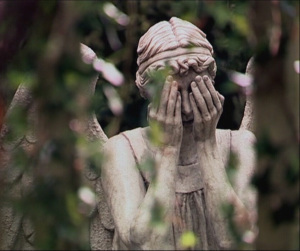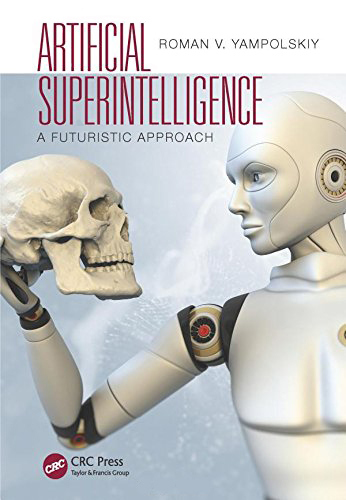Cynthia Sue Larson's Blog, page 12
November 30, 2015
Foundations of Mind II Papers Published in Cosmos and History
 Foundations of Mind II: A Dialogue of World Views Issue of Cosmos and History
Foundations of Mind II: A Dialogue of World Views Issue of Cosmos and History
Papers from the 2015 Foundations of Mind II: A Dialogue of World Views conference held at UC Berkeley are now published in Cosmos and History: The Journal of Natural and Social Philosophy in Volume 11, Number 2.
This is the second special edition of Cosmos & History on Foundations of Mind (FOM), which was held at the University of California, Berkeley between August 13th and 15th 2015.
The foundations of mind (FOM) project actively produces solutions to 21st century crises in education and research and resolving ecological and social concerns, through a new approach to mind and society. Foundations of Mind runs an annual conference and an online college, and produces peer-reviewed work in neuroscience, HCI, cognitive science, biology and philosophy that have received the highest accolade of being accepted both to be taught for credit and formally academically sponsored at both Stanford and UC Berkeley.
Abstracts and full-length papers from the 2015 Foundations of Mind conference can now be read at:
http://www.cosmosandhistory.org/index.php/journal/issue/current
Introduction to the Special Issue: Foundations of Mind II: A Dialogue of World-Views
ABSTRACT PDF
Seán Ó Nualláin
1-7
The Neoclassical Interpretation of Modern Physics and it Implications for an Information Based Interpretation of Spirituality
ABSTRACT PDF
Shiva Meucci
8-27
An Entangled Dream Series: Fragmentation, Wholeness and the Collective Unconscious
ABSTRACT PDF
Judy B. Gardiner
28-46
Beyond Conception: Ontic Reality, Pure Consciousness and Matter
ABSTRACT PDF
Leanne Whitney
47-59
The Circle of Explanation in the Sciences
ABSTRACT PDF
Seán Ó Nualláin
60-82
The Biofield: Bridge Between Mind and Body
ABSTRACT PDF
Beverly Rubik
83-96
The Emergent Dualism View of Quantum Physics and Consciousness
ABSTRACT PDF
Christopher Tyler
97-114
QEEG Studies of the Acute Effects of the Visionary Tryptamine DMT
ABSTRACT PDF
Juan Acosta-Urquidi
115-129
Fractal Cognitive Triad: The Theoretical Connection between Subjective Experience and Neural Oscillations
ABSTRACT PDF
Justin M. Riddle
130-145
Quantum Mechanics & the Brain, and some of its Consequences
ABSTRACT PDF
Acacio de Barros, Gary Oas
146-153
A Review of the Method of Using the Scalp Electric Field in EEG Analysis
ABSTRACT PDF
Claudio Carvalhaes, J. Acacio de Barros
154-159
On the Necessity of Including the Observer in Physical Theory
ABSTRACT PDF
Wolfgang Baer
160-174
Fundamental Mathematics of Consciousness
ABSTRACT PDF
Menas Kafatos
175-188
Biophotonic Route for Understanding Mind, Brain and the World
ABSTRACT PDF
Rajendra Prasad Baijpai
189-200
Measurements and Knowledge
ABSTRACT PDF
Carlos Montemayor
201-204
The Origin of Thinking: Restoring the Living Roots of Rational Consciousness
ABSTRACT PDF
Glenn Aparacio Parry
205-213
Streams Touching Consciousness: Sensoriality and the Ontology of Repetition
ABSTRACT PDF
Katja Pettinen, Myrdene Anderson
214-227
Transcultural Perspective on Consciousness: a bridge between Anthropology, Medicine and Physics
ABSTRACT PDF
Tania Re, Carlo Ventura
228-241
The Systems View of Life A Unifying Conception of Mind, Matter, and Life
ABSTRACT PDF
Fritjof Capra
242-249
The Absence That Gives Rise to Our Presence: Humanity’s Capacity to Share a Common Sense
ABSTRACT PDF
Sperry Andrews, Jennifer Tayloe
250-268
The Physics of Symbols Evolved Before Consciousness
ABSTRACT PDF
Howard Pattee
269-277
Highest Ground
ABSTRACT PDF
Rodney Ferguson
278-289
The Science of Biogeometry
ABSTRACT PDF
Jerry Gin
290-309
FOM: On the Nature of Quantum Dynamical Variables
ABSTRACT PDF
James R. Johnston
310-325
Primacy of Quantum Logic in the Natural World
ABSTRACT PDF
Cynthia Sue Larson
326-340
Videos from the conference presentations will be available through the Foundations of Mind website, and papers will be published in the future, too. Register through Foundations of Mind to join in on-going conversations exploring topics of the quantum paradigm, consciousness, biosemiotics, and higher education.
___________________________
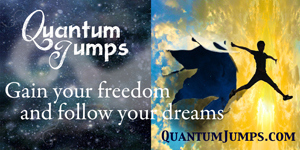 Cynthia Sue Larson
is the best-selling author of six books, including Quantum Jumps. Cynthia has a degree in Physics from UC Berkeley, and discusses consciousness and quantum physics on numerous shows including the History Channel, Coast to Coast AM, the BBC and One World with Deepak Chopra. You can subscribe to Cynthia’s free monthly ezine at: http://www.RealityShifters.com
Cynthia Sue Larson
is the best-selling author of six books, including Quantum Jumps. Cynthia has a degree in Physics from UC Berkeley, and discusses consciousness and quantum physics on numerous shows including the History Channel, Coast to Coast AM, the BBC and One World with Deepak Chopra. You can subscribe to Cynthia’s free monthly ezine at: http://www.RealityShifters.comRealityShifters®


November 20, 2015
Guest blog: The Bionoetics Manifesto
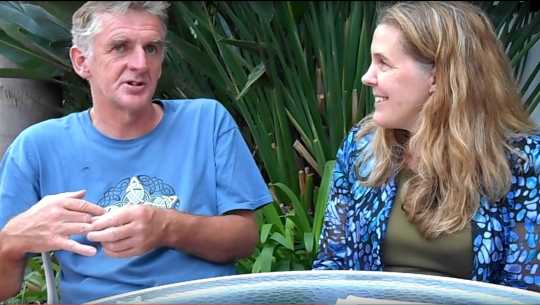 I spoke recently with Dr. Seán Ó Nualláin, whom I’ve interviewed on this blog before. Seán holds a Ph.D. in Computer Science from Trinity College, Dublin Ireland. He was a visiting scholar at Walter Freeman’s lab at UC Berkeley, and also faculty at Cal and Stanford. Seán is the author of several books, including “One Magisterium,” and he runs the Foundations of Mind project.
I spoke recently with Dr. Seán Ó Nualláin, whom I’ve interviewed on this blog before. Seán holds a Ph.D. in Computer Science from Trinity College, Dublin Ireland. He was a visiting scholar at Walter Freeman’s lab at UC Berkeley, and also faculty at Cal and Stanford. Seán is the author of several books, including “One Magisterium,” and he runs the Foundations of Mind project.
One of the ideas mentioned in One Magisterium is the notion of bionoetics, a term Ó Nualláin first coined in a paper published in 2007 in a review of Gunther Witzany’s The Logos of the Bios. Ó Nualláin’s idea of bionoetics was subsequently described by Witzany as a method, “at one with the universal laws of nature without embracing scientific reductionism, but instead looking at the whole. New generations of science, fine arts and spirituality, freed of former dogmatic traditions, will be able to do justice to this approach.”
While the idea of Bionoetics may seem so novel as to be at first hard to imagine or fully comprehend, Ó Nualláin has now written a manifesto on Bionoetics, which I am honored to reblog.
_________________
The bionoetics manifesto
Aside from massive student debt and risible employment prospects for Ph D’s, the early 21st Century University has other profound problems. The disciplinary structure is a mess of different geological strata, excluding the 21st century and its urgent need for focused departments dealing with hitherto “interdisciplinary” subjects like Cognitive Science.
In the age of the ubiquitous smartphone, students are asked to perform an acting job in pretending that their professors are more competent than those available through a single click on a browser. In the age of readily available neatly archived knowledge, a mafioso level scam is implemented with “anonymous” review , cartels of professors introducing their students to the fleshpots of the conference circuit, and interlocking boards of capi–sorry, journal editors. Of course, this feeds into the “tenure “ scam, where a historical deal between the state and scholar to secure academic freedom for the latter is now a dead letter.
The solutions are blindingly simple. All basic courses are now available for minimum charge of the web. Academic articles can transparently be posted for equally transparent peer review and appropriately edited by the original writer, who might alternatively agree to disagree or ignore. Cui bono the present system? The corporation-dominated university and immensely profitable journals to start with.
Yet there is a darker agenda at work. The demonic social forces unleashed by the attempted neoconservative coup of 2000-2008 have been transmuted into a paralysis of political will. It suits purveyors of neoliberalism that students of political science can be indoctrinated to look away from the Wiki leaks revelations of how diplomacy actually works. It suits them also that psychology students are not taught the elements of objective math models of reality and the real political order.
All this can easily be changed, and this is but a short foray into the area. Apart from the crisis in replicability of results and consequent retraction of papers that characterizes 21st century science, there are vast swathes of potential knowledge that remain unexplored as a result of the idiot savant microfocus of current science. “Dark energy” and “dark matter” are too well-known to be rehearsed here, are suggestive of a stage of crisis in science, but are mirrored in other areas. Examples are the fact that the “dark energy”/default network of the brain is currently suggested as absorbing metabolic process even when no cognition is taking place; linear models of the neuron are clearly too simple; the “dark nucleotides” result in non-coding rmas that actually code by any computing definition; and so on.
The recent accidental (sorry, “serendipitous”) discovery of CRISPR mechanisms now means that gene-editing is at the stage that Monsanto assured us a generation ago they had achieved. This opens a Pandora’s box of speculation about corporate influence on science, already accepted in medicine to the extreme that corporations have gotten so concerned about academics whoring themselves that they have started to do their own replication studies.
Contemptible as such influence is, the problem is deeper still. It is clear, after the bail-outs post-2008, that the number one value in our society is the right of quants to fiddle with numbers and, by financializing the economy, introduce what has become a neo-feudal system. The state pays for this economized status quo–using taxpayers’ money against them–and then requires that the universities produce graduates to work in this Procrustean Uber/taskrabbit dystopia in the name of “competitiveness” in a market that has been carefully jury-rigged.
The result is that talented artists are being removed from the gene line as it becomes too expensive for them even to afford the white picket fence, let alone the house. It should be the duty of universities to ensure that humanities and arts graduates assert the transcendence of the realities to which great art points, be that transcendence achieved through language (like Mallarme) or conceived of as contact with an objective reality (like Beethoven). Nothing of the sort happens; indeed. this writer has sat at seminars with classical music students forced to endure disquisitions about Beyonce videos. If it is all about feelings – as distinct, say, from exploring the stack depth in Beethoven’s recursive motif in the fifth – why bother with reality and value judgement?
Similarly, the social sciences feature instruction in Atheism 101 (using the Dover trial as a straw man) and – more subtly – an injunction to the students to regard political facts only insofar as they are relative to psychology. Famously, the Kerry 2004 campaign was ill-advised along these lines. Of course, you may not be interested in politics, but politics is interested in you, and such weak epistemological fences are easily breached later in life.
So what can be done? It is clear that we cannot proceed further without looking at the goals of the larger society, which should include human beings living healthily in safe communities and free to explore their relation with a reality conceived of as wonderful. Tertiary education is a critical part of this, and has become subverted. So we can insist on total transparency in all research and pedagogy as a first step. We do not have to resort to new age woo-woo whose only virtue is a radical assertion of the reality of subjectivity; the current structure of the academy leaves unexplored many fertile areas of research on things meaningful to people. We can in fact build a structure of research and teaching built on a set of ineluctable propositions about humanity’s relation to reality that cannot, even in principle, ever contradict best practice in science
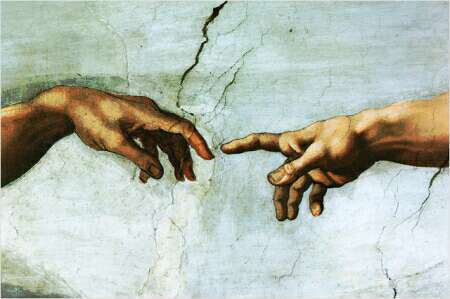 One is to insist–the central Bionoetics propositions–that we humans are a process in which the universe has come to know itself, and that math exemplifies this. Before the acceleration of mathematical knowledge in the renaissance, we built sophisticated societies based on co-operation through language; since then there has been a vast acceleration Mathematics is neither more nor less than the most elliptical and precise expression of the cosmos knowing itself through us. This is irrefutable (as distinct from true, a slippier concept); the index of access to an objective reality through all the travails of constructivism, psychologism etc is the litmus test of math models working in areas like QM. Math contains access to entities historically conceived of as Platonic (cosine, pi, etc) as well as reflections of our cognitive and social systems. Indeed, math may be illogical as anyone who struggled with infinities knows; it may work in contexts it shouldn’t with “bad” methods like non-converging infinities and QFT; underlying its success is surely something deeper than “cognitive” operations.
One is to insist–the central Bionoetics propositions–that we humans are a process in which the universe has come to know itself, and that math exemplifies this. Before the acceleration of mathematical knowledge in the renaissance, we built sophisticated societies based on co-operation through language; since then there has been a vast acceleration Mathematics is neither more nor less than the most elliptical and precise expression of the cosmos knowing itself through us. This is irrefutable (as distinct from true, a slippier concept); the index of access to an objective reality through all the travails of constructivism, psychologism etc is the litmus test of math models working in areas like QM. Math contains access to entities historically conceived of as Platonic (cosine, pi, etc) as well as reflections of our cognitive and social systems. Indeed, math may be illogical as anyone who struggled with infinities knows; it may work in contexts it shouldn’t with “bad” methods like non-converging infinities and QFT; underlying its success is surely something deeper than “cognitive” operations.
In the social sciences, students should indeed be taught the techniques of graph traversal that constitute modern literacy. Yet it should be done in a context in which it is made clear to them that in the political sphere they are objects more than subjects, not to believe everything they think as our century has witnessed development of expertise in implanting narratives. In the arts it should be insisted that artists are often consumed by a vision of a reality transcendent to them, and the formal techniques they use (like Beethoven’s stack, and his innovation of the diminished chord) should be explicated in properly respectful fashion.
Medicine should indeed focus on health rather than illness and preventive rather than cure or (the other extreme) “prospective medicine, with Prozac being introduced to countries newly told they’re depressed. Biology is in such crisis that it is the poster child for new explanatory schemas in science. Psychology does not yet exist, 150 + years after its initial replicability crisis. For the moment, we might insist on “psychological’ concepts like simultaneity copying their correlates in physics.
Now, of course, we have to make money. Or do we? For it is clear that the current model involves burdening students with debt so they will later be dutiful consumers. If there is a revenue stream, it will be in interdisciplinary degrees with max $1k a year fees and astutely chosen research topics like those mentioned above. That may never make much money, but presenting it as an alternative is a radical and salutary acy.
However, there is another possibility; introducing the scheme to students of science and the arts as an entrée into a vast, numinous, transcendent reality unavailable to them in the other colleges they are contemplating. For social scientist aspirants, we might point out that the activism that most of them are drawn to requires intimate knowledge of the forces in our complex society, and being told it is all relative to their minds is useless. For performing artists, we can stress that sophisticated performance is likewise a profoundly revolutionary political act and one for which they should demand respect.
_________
Dr. Seán Ó Nualláin holds a Ph.D. in Computer Science from Trinity College, Dublin Ireland. He was a visiting scholar at Walter Freeman’s lab at UC Berkeley, and also faculty at Cal and Stanford. Seán is the author of several books, including “One Magisterium,” and he runs the Foundations of Mind project.
___________________________
Cynthia Sue Larson is the best-selling author of six books, including Quantum Jumps. Cynthia has a degree in Physics from UC Berkeley, and hosts Living the Quantum Dream on the DreamVisions7 radio network. She discusses consciousness and quantum physics on numerous shows including the History Channel, Coast to Coast AM, the BBC and One World with Deepak Chopra. You can subscribe to Cynthia’s free monthly ezine at: http://www.RealityShifters.com
RealityShifters®


October 27, 2015
Nonduality and Acceptance with Joan Tollifson
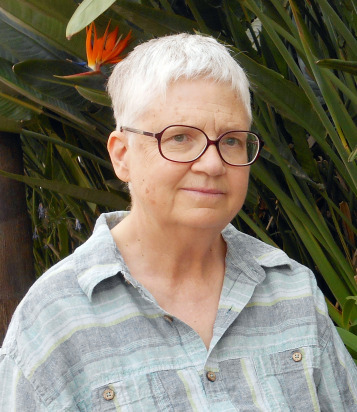
Joan Tollifson
Joan wrote about her experience having been born in the 1940s and growing up with only one hand in her book, Bare-Bones Meditation, Waking Up from the Story of My Life.
Many years later, Joan discovered that her missing hand was a kind of gift–in that she was given a kind of ticket to “the secret rooms of people’s hearts where something is always missing or misshapen.” In childhood, Joan realized that she stood out with a disability that nobody was supposed to point out or talk about. Tollifson advocates a stripped-down meditation practice that is not dependent on any program, method, techniques, or specific practices. Joan writes,
“Meditation is seeing the nature of thought, how thought constantly creates images about ourselves and others, how we impose a conceptual grid on reality and then mistake the map for the territory itself. Most of the time we aren’t even aware that thought is taking place. Meditation is realizing, on ever more subtle levels, that it is. When conceptualization is seen for the imaginary abstraction that it is, something changes.”
I especially relate to this definition of meditation, as well as Joan’s subsequent observations that meditation is listening–really, really deep listening. There can be strength in accepting who one is, even (perhaps especially) when it’s not socially popular, such as being a disabled lesbian in the 1960s.
I can’t be helped but be touched by Joan’s life journey, filled with learning to face challenges with courageous dedication and commitment. I am deeply touched by the integrity and spirit it took for Joan to break through habitual thinking and truly walk her talk of becoming self-knowing and self-aware. It’s easy for most of us to become lulled back into complacency, resting on laurels of past spiritual accomplishment. It’s inspiring to see how for some people like Joan, fitting in simply is not an option–and meditative practice more than just something nice to do. It can be genuinely life-saving.
What Joan Tollifson Knows for Sure
I was pleased and honored to meet Joan Tollifson at the Science and Nonduality conference in San Jose, California. Joan gave a talk about “Being just this moment,” featuring aspects of her “bare bones” variety of Buddhism. It seemed fitting to meet with her in the gardens at the Dolce Hayes mansion, where we were surrounded by trees, flowers, and the occasional hummingbird. I was honored to ask Joan what she feels she knows for sure that most people aren’t aware of, that could greatly benefit the world. You can see her response to my question in this YouTube video.
___________________________
Cynthia Sue Larson is the best-selling author of six books, including Quantum Jumps. Cynthia has a degree in Physics from UC Berkeley, and hosts Living the Quantum Dream on the DreamVisions7 radio network. She discusses consciousness and quantum physics on numerous shows including the History Channel, Coast to Coast AM, the BBC and One World with Deepak Chopra. You can subscribe to Cynthia’s free monthly ezine at: http://www.RealityShifters.com
RealityShifters®


The Truth About Men’s Intuition
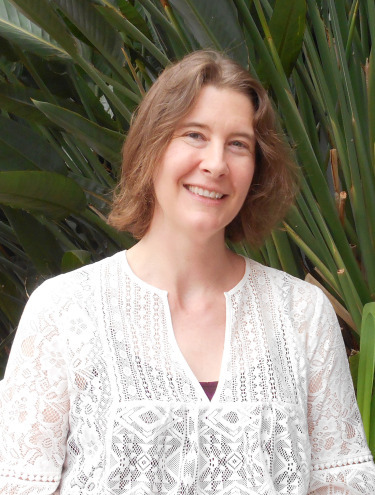
Culturally, we assume there is such a thing as women’s intuition, and we might also presume women feel more excited than men about being right–but according to one researcher’s studies, these assumptions are not necessarily true.
Dr. Julia Mossbridge has co-authored a paper, “Predicting the Unpredictable,” investigating the fascinating realm of Predictive Anticipatory Activity (PAA), about the way researchers can record physiological evidence of a person’s physiological changes–such as in the cardiopulmonary, skin, and/or nervous systems–in advance of the occurrence of a stimulus. What is being studied is thus not so much a person’s conscious awareness of “knowing the future” or assertion of premonitions, so much as their unconscious physiological reactions based in the autonomic and central nervous systems.
At the recent Science and NonDuality (SAND) conference held in San Jose, California, Mossbridge showed slides depicting the way men and women respond very differently to participating in an experiment in which their task is to guess which picture will be shown next, as randomly selected by a computer program after they’ve made their selection. When participants balked, saying something like, “I don’t know what picture will be chosen next!” Mossbridge reassured them, replying, “I know! That would be weird, right? But that’s what this study is about.”
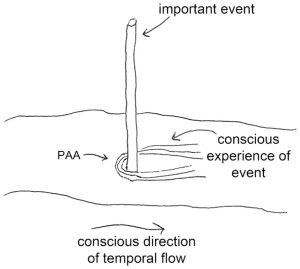
A recent meta-analysis indicates that the human body can apparently detect randomly delivered stimuli occurring 1–10 s in the future (Mossbridge etal., 2012).
Unconsciously Sensing Future Events
The premise here is that sometimes we may unconsciously sense when a predator arrives, just before it actually approaches within striking distance. And sometimes you might get a sense that it’s time to shut a computer game you’re playing, just before your boss walks into your cubicle.We could benefit from clear evolutionary advantages if it’s true that our unconscious physical awareness is able to pick up advance ripples of such significant future events.
We can thus ask the question if, much in the same way that we’d feel turbulence in a raft floating down a river just before we reach an obstacle in the path of the river’s flow, is it possible that we can feel advance “ripples” prior to actual occurrence of significant events?
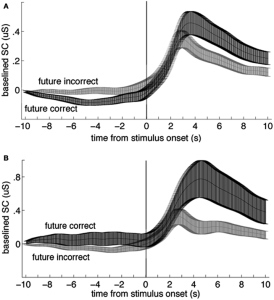
Figure 1. Examples of data that would be coded with a negative (A) and a positive (B) sign for the effect size.
Different Patterns for Men and Women
In her talk at the 2015 San Jose SAND, Julia Mossbridge shared findings from a meta analysis study she conducted in 2012, “Predictive Physiological Anticipation Preceding Seemingly Unpredictable Stimuli: A Meta-Analysis.” Intriguingly, men and women’s abilities to demonstrate physiological evidence of advance awareness of coming events occurs in opposing patterns. Namely, men’s responses include higher physiological arousal more consistently both before and after they find out whether or not their guess as to which of four pictures would be selected is shown to be correct. When showing undergraduate students a series of visual images in randomized order, Mossbridge noted that men and women show very different and readily distinguishable differences in galvanic skin response and heart rate before and after their non-conscious awareness indicates recognition of an image. Men became additionally aroused to find that somehow, their bodies “knew” what images would flash next, and demonstrated an opposite pattern from women, who were not so excited to find out they’d somehow tuned into the future.
Are We “Conscious Puppets”?
In her talk at SAND, Mossbridge pointed out how interesting it is that we are not aware of what it is to be anything other than ourselves. This may seem to be a trivial point, but indeed it is not. While we may be vaguely aware of levels of our awareness that are non-conscious, we sometimes have difficulty reconciling just how strongly the non-conscious “puppet-master” may be moving our “conscious puppet” selves.
Mossbridge pointed out that we might well wonder whether there is anything “we” can do to bridge the gap, which immediately presents us with the question, “Who is ME?” Am I the puppet? Or am I the puppetmaster? She concluded her SAND talk by saying that how you answer who you think you are answers the question about bridging the gap.
What Julia Mossbridge Knows for Sure
I was honored to meet with Julia Mossbridge and ask him what he feels he knows for sure that most people aren’t aware of, that could greatly benefit the world. You can see in her response to my question in this YouTube video.
___________________________
Cynthia Sue Larson is the best-selling author of six books, including Quantum Jumps. Cynthia has a degree in Physics from UC Berkeley, and hosts Living the Quantum Dream on the DreamVisions7 radio network. She discusses consciousness and quantum physics on numerous shows including the History Channel, Coast to Coast AM, the BBC and One World with Deepak Chopra. You can subscribe to Cynthia’s free monthly ezine at: http://www.RealityShifters.com
RealityShifters®


October 26, 2015
Experiencing Science and Nonduality
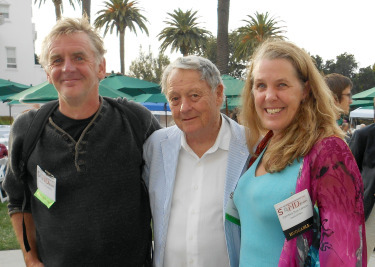
Sean O’Nuallain with Henry Stapp and Cynthia Sue Larson at SAND US 2015
Aware of Being Aware
The atmosphere at this year’s Science and Nonduality (SAND) US conference was relaxed and energized, with a friendly, easy-going, inquisitive vibe. With dozens of speakers presenting talks and workshops in six different rooms and additional areas–including an outdoor dome–SAND provided a veritable smorgasbord of ideas and experiences. The theme at this conference was “On the edge of the (un)known,” graphically portrayed on the main stage backdrop and on conference program books with the image of a person standing atop a rolling 3D topographical map hill and looking up at the stars.
Held at the Dolce Hayes Mansion in San Jose, California, and attracting hundreds of attendees, this sixth annual conference in the USA filled four days with dawn-to-dusk opportunities to participate in hands-on activities. SAND’s mission is “to forge a new paradigm in spirituality, one that is not dictated by religious dogma, but that is rather based on timeless wisdom traditions of the world, informed by cutting-edge science, and grounded in direct experience,” and it succeeds in creating a welcoming atmosphere for meeting new friends and old who share a common interest in the place where science and spirit meet.
I enjoyed attending many wonderful sessions, taking 56 pages of notes, and spending hours talking with friends and colleagues about the high points of some of the sessions I was unable to attend. There were often at least six concurrent sessions happening simultaneously, making it impossible to see all of everything–and sometimes with so much going on, it was nice to enjoy good food, company, and drink, often with live music nearby.
Thought-Provoking Talks
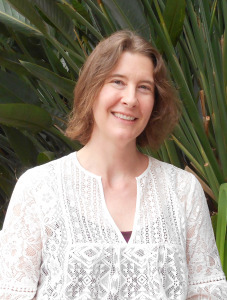
Julia Mossbridge
I greatly enjoyed attending Julia Mossbridge‘s talk about her ground-breaking precognitive research studies at Northwestern University. When showing undergraduate students a series of visual images in randomized order, Mossbridge noted that men and women show very different and readily distinguishable differences in galvanic skin response and heart rate before and after their non-conscious awareness indicates recognition of an image. Men became additionally aroused to find that somehow, their bodies “knew” what images would flash next, and demonstrated an opposite pattern from women, who were not so excited to find out they’d somehow tuned into the future. Mossbridge pointed out how interesting it is that we actually are not aware of what it is to be anything other than ourselves. This may seem to be a trivial point, but indeed it is not. While we may be vaguely aware of levels of our awareness that are non-conscious, we sometimes have difficulty reconciling just how strongly the non-conscious “puppet-master” is moving our “conscious puppet” selves. I’ll be sharing more from Dr. Mossbridge in a future post, since she was so kind as to grace me with an interview where she shared what she knows for sure that most people don’t realize, that can positively change the world.
Donald Hoffman‘s talk about “Conscious Agents” presented his approach to viewing perception and consciousness through the lens of an Evolutionary Interface Theory. Hoffman’s big idea that came to him after years of research in perceptual studies is that all of true reality is something we presume to know, while research continues to show that actually we never see any such “true” reality, but instead only ever actually experience a kind of perceptual interface–something akin to the desktop on our computer in which various icons for folders and trash represent something of deeper levels of complexity that we need not trouble ourselves to fully comprehend.
Hoffman’s colleague, Chetan Prakash, presented a talk on the two fundamental elements of “Conscious Realism” that provide a basis by which Hoffman’s theory can best be understood: Universal Darwinism in which the fittest survive not for best seeing and knowing the truth, but rather when best interfacing with required resources; and Bayesian Inference in which possibilities are constantly evaluating probabilities based on current information.

Henry Stapp
Henry Stapp‘s talk “On the Nature of Things,” was unquestionably the most referenced by other speakers on a wide variety of stages throughout the conference, and he brightened the stage with his appearance on a panel with Stuart Hameroff, Julia Mossbridge, and Donald Hoffman discussing the definition of consciousness. Stapp posed a question regarding how the Hameroff/Penrose microtubules theory can address the matter that when a “Bing!” occurs in which spontaneous collapse occurs in an experience, there can be times when there is a conscious experience, yet there is no history, which appears to be a problem with their theory. Stapp cited William James’ Harvard lectures stating that without memories of the past, we wouldn’t have history.
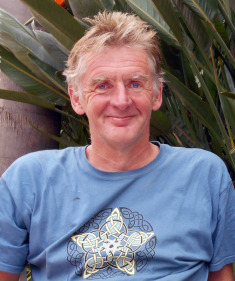
Seán Ó Nualláin
Seán Ó Nualláin‘s talk referenced ideas of Gurdjieff and Pierre Teilhard de Chardin while describing the importance of voluntary will in directing consciousness, and “One Magisterium.” Ó Nualláin’s illuminated the distinction between exogenous, automatic attention we don’t consciously control, and endogenous attention that we do. There exists an Archimedean point from where we can step outside and see the self as composed of simple elements, and by which we can observe mind as pure consciousness, observing self from one configuration to another. We can reparse Nature, asking, “What can I know? What can I hope for? What am I?” As we look more closely at we know for sure to be true, and see entangled realities between symbols and metabolism, the best conceptualizations lie beyond 1st and 2nd order tensors constrained by limitations of linear models to chaotic dynamics and 4th order tensor conceptualizations.
Justin Riddle presented his Tri-W0rld model that brings mind-body-spirit complementarity into our view of quantum-digital-fractal computers. Quantum characteristics of superposition of states, wave function collapse upon measurement, and entanglement also can be fitted to this mind-body-spirit triumvirate. Riddle described how neural oscillations come in bursts of neural spiking, with windows of coherence, as part of an oscillating mind in which some neurons become “hyper neurons” and only operate together. We see signs of levels of oscillation in our mind in Theta brain waves oscillating at a rate of five times per second of perceptual awareness, Delta brain waves oscillating at a rate of two times per second for actions and decisions, and Alpha brain waves oscillating at one time per ten seconds for attention associated with the Default Mode Network of the brain, forgiveness and meditation.
Zoran Josipovic talked about “The Unified Context of Consciousness,” in which studies show that when people are taught love and compassion, their brain wave states change in positive ways that reduce epileptic hypersynchrony, and provide people with pervasive sense of having an awareness of being aware.
Bernard Kastrap set the stage for talking about Non-duality and Panpsychism by pointing out that there is experience–aka: behavior of That Which Experiences–and there is That Which Experiences (TWE). A second person perspective emerges through dissociation when one’s psyche creates an “alter” consisting of illusory islands of local perception, with sense perception occurring at boundaries. “Cosmic mind has Dissociative Identity Disorder,” says Kastrap, adding that the error of panpsychists is in thinking of of mind as fragmented. When we assume structure of the behavior of consciousness to be that of consciousness itself, we see that a non-dual perspective does not make this mistake–“The water doesn’t derive its structure from ripples.” Kastrap asserts that Artificial sentience (AI) assumes panpsychism, assuming matter is fragmented and complex minds would be created from the bottom up. “The quest to create a sentient being is a quest to induce dissociation in the cosmic mind,” adds Kastrap, stating that the inner life of each living being is a dissociated alter of One.
Stephan Pollaine shared evidence of reincarnation, ghosts, and other examples illustrating the illusory nature of ego self. We can explore consciousness subjectively with meditation, breath work, prayer, fasting, service, and guidance from a teacher or shaman.
Edward Frenkel gave a talk about “Cartesianism as the Effect of Our Collective Childhood Trauma,” in which he described how much of our suffering comes from fear of death, and bottling up emotions from our childhood. Cartesianism is a process by which we accept representations as being real, thus confusing representations with experiences. With Ray Kurzweil now working at Google, with his eyes on the prize of somehow creating an avatar of his deceased father from memories and photos, it’s clear to Frenkel that when our inner child is hurt, we create stories as defense mechanisms. Frenkel adds, “The pain is finite, and we are infinite. Trust me. I’m a mathematician.” Frenkel encourages scientists to share their personal experiences, and experience the kind of breakthrough he had on stage at last year’s SAND in the USA in which, after dealing with tremendous inner doubts and concerns about ruining his reputation by speaking at SAND, he had an awareness epiphany while being taped for a YouTube video giving his talk and his powerpoint slideshow didn’t work–so he spoke from his heart. Frenkel ended his talk with a quote from Lewis Mumford’s “The Myth of the Machine,” “But for those of us who have thrown off the myth of the machine, the next move is ours: for the gates of the technocratic prison will open automatically, despite their rusty ancient hinges, as soon as we choose to walk out.”
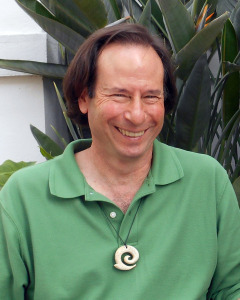
Glenn Aparicio Parry
There were many more talks and events than I was able to attend this year, but I heard wonderful buzz about presentations given by: Juan Acosta, Duane Elgin, Stephen LaBerge, Maria Syldona, Adam Bucko, Matthew Wright, Sky Nelson, Mauro Zappaterra, Mikey Siegel, Karla Galdamez, Wolfgang Baer, Peter Russell, Glenn Aparicio Parry, Robert Thurman, Joan Tolifson, Samantha Sweetwater, and Charles Eisenstein. One of the headliners at this conference was Deepak Chopra, who frequented the main stage and halls over the course of the conference, along with the husband-wife founders of Science and Nonduality, Zaya and Maurizio Benazzo.
I will be following this post with several more posts featuring four wonderful presenters I had the privilege to interview at SAND this year: Glenn Aparicio Parry, Joan Tolifson, Julia Mossbridge, and Seán Ó Nualláin, along the lines of the mini interview I conducted with Menas Kafatos included here.
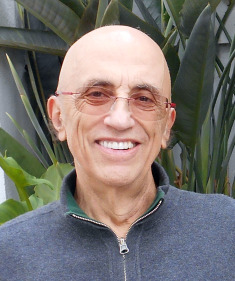
Menas Kafatos
What Menas Kafatos Knows for Sure
Dr. Menas Kafatos is the Fletcher Jones Endowed professor of Computational Physics and the Director of the Center of Excellence at Chapman University, and he has published numerous books and articles. Kafatos is one of the five Science and NonDuality SAND conference board members, and he started a talk at SAND with an experiential breathing meditation, to provide the audience with the feeling of non-duality, and an appreciation for being in a state of receptive witnessing awareness to how we exist in-between inhalation and exhalation, with each breath. Kafatos pointed out, “Consciousness is not a problem that needs to be solved,” and explained that much like breathing, consciousness just is. Kafatos proceeded to outline a framework for understanding reality, with its three qualities of: (1) Integrated polarity (complementarity), (2) Correspondence (recursion), and (3) Creative interactivity (process).
For any serious seeker and scholar in the field of consciousness who’s been attending conferences for the past 17 years like I have, many SAND speakers will be familiar. Yet amidst familiar topics and faces, I share the sentiment Menas Kafatos expressed in his SAND talk when he said, “You don’t have to come to conferences. We come so we can be together!”
I was honored to meet with Kafatos and ask him what he feels he knows for sure that most people aren’t aware of, that could greatly benefit the world. And much to my delight, Menas truly sparkled as he contemplated an answer to my query, as you can see in his response to my question in this YouTube video.
___________________________

Cynthia Sue Larson is the best-selling author of six books, including Quantum Jumps. Cynthia has a degree in Physics from UC Berkeley, and hosts Living the Quantum Dream on the DreamVisions7 radio network. She discusses consciousness and quantum physics on numerous shows including the History Channel, Coast to Coast AM, the BBC and One World with Deepak Chopra. You can subscribe to Cynthia’s free monthly ezine at: http://www.RealityShifters.com
RealityShifters®


October 3, 2015
Improve Your Life with the Quantum Zeno Effect
How can you make the most of the “quantum watched pot” effect in your life?
Most of us are familiar with those situations where it seems that the more we stare at a given situation, waiting for a momentous phase change to occur, the less likely it seems we’ll see much of anything interesting transpire. You might have heard your mother cluck, “A watched pot never boils,” suggesting you find something more productive to do. What your mother might not have known and probably didn’t tell you is that the “watched pot” phenomenon is backed up by some pretty interesting scientific studies in quantum physics that show considerable promise for helping improve our way of life.
We might envision the possibilities of being able to freeze-frame a given situation–such as a life-threatening experience–in order that we can best address whatever needs to be handled. Some people, including me, have had such moments where we could have sworn that time slowed to a stop–and the Quantum Zeno Effect can go a long way toward explaining what’s going on when that happens.
The Quantum Zeno Effect
While Alan Turing has been acknowledged as having first mentioned the basic principle behind the Quantum Zeno Effect in the form of a paradox in 1954, physicists Baidyanaith Misra and George Sudarshan were the first to write a paper in 1977, hypothesizing that if a quantum system is measured often enough, it’s state will be unable to progress, and this hypothesis was tested and proven to be true in a 1989 experiment involving laser-cooled ions trapped in electric and magnetic fields. Subsequent tests further confirmed that the Quantum Zeno Effect works, and in 2013, researchers moved a step closer to building quantum computers by demonstrating that objects as large as diamonds can exhibit the Quantum Zeno Effect. [Reich 2013] It’s a big leap to move from the realm of the microscopic to something large enough that humans can directly see, feel and work with, such as diamonds. In addition to the Quantum Zeno Effect that effectively freezes a system into a given state, there also exists an anti-Zeno Effect, which moves a system quickly out of a given state.
In 2014, a team of physicists led by Y.S. Patil at Cornell University successfully demonstrated that rapid repetitive measurements can effectively freeze a system in place. The potential implications of this are huge, as the paper asserts, “The techniques demonstrated here… … augur intriguing prospects of realizing novel many-body interactions such as a measurement- induced dynamic coupling between the internal, motional and topological states of a quantum many-particle system.” [Patil 2014]
If you’re a fan of the science fiction TV show, Dr. Who, you might remember the Blink episode featuring some nefarious beings that look like statues. Dr. Who warned his friends, “Fascinating race, the Weeping Angels. The only psychopaths in the universe to kill you nicely. No mess, no fuss, they just zap you into the past and let you live to death. The rest of your life used up and blown away in the blink of an eye. You die in the past, and in the present they consume the energy of all the days you might have had, all your stolen moments. They’re creatures of the abstract. They live off potential energy.” Dr. Who advised how best to prevent being zapped to the past with some additional advice, “Don’t blink. Don’t even blink. Blink and you’re dead. They are fast. Faster than you can believe. Don’t turn your back, don’t look away, and DON’T blink.”
While we likely won’t have much need to freeze Weeping Angels, there are times when some of us experience a need for time to slow to a stop, and some of us have experienced that phenomena, as once happened to me when I was walking through the Lausanne train station in Switzerland where we living at the time, behind my husband and daughter. My husband and I were both carrying suitcases in both hands–and he was also carrying our daughter perched up on his shoulders, holding on tightly to his hair. I watched in alarm as I saw my daughter raise her hands up in the air, letting go of her father’s hair and bouncing along happily with each large step he took. I’m quite sure I didn’t blink as I kept watching as her back arched and her head came down toward the granite floor. At this point, I heard and saw time seem to slow to a stop, as what had been the high-pitched frequency of women’s high heeled shoes lowered down to a deep, slow roar. I was able to cover a great deal of distance very quickly, just in time to catch my daughter while she was falling head-first toward the hard floor. [Larson 2011]
So the Quantum Zeno Effect might be one possible explanation as to why my not blinking and great perceived need in that given moment resulted in time seeming to slow to a stop–but how might the Quantum Zeno Effect be useful in more typical situations in daily life?
Human Cognition and Quantum Zeno Effect
The Quantum Zeno Effect was never considered something to be cloistered away in the exclusive domain of physicists. Some scientists note that human perception can be influenced by the Quantum Zeno Effect when individuals are coupled with their environment in such a way that one of the original discoverers of Quantum Zeno Effect. Sudarshan, one of the original co-authors of the first 1977 paper about the Quantum Zeno Effect imagined a type of awareness in which “sensations, feelings, and insights are not neatly categorized into chains of thoughts, nor is there a step-by-step development of a logical-legal argument-to-conclusion. Instead, patterns appear, interweave, coexist; and sequencing is made inoperative. Conclusion, premises, feelings, and insights coexist in a manner defying temporal order.” [Sudarshan 1983][Atmanspacher 2013]
Cognitive scientists Zheng Wang and colleagues have noted the tremendous potential for quantum theory to build better models of human cognition, recognizing that unlike classical models, quantum models more accurately predict human probability judgements, as well as the way people’s answers tend to change depending on the sequence of questions being asked. Human decision processes can much more accurately be predicted with quantum models, as can subconscious reasoning and the way words and meanings are grouped. [Wang 2013]

illustration from Quantum Jumps: An Extraordinary Science of Happiness and Prosperity
Choosing What We Pay Attention To
In addition to utilizing the Quantum Zeno Effect in times of emergencies, or as I’ve previously described to break long-standing habits and addictions, such as Cell Phone Addiction, one the biggest benefits we can gain from harnessing the powers of the Quantum Zeno Effect is from experiencing more of what we enjoy, when we focus our attentive awareness on what we most appreciate and enjoy. Researchers have noted that one of the very best ways to overcome depression is to make note each day of a few things we are grateful for that we had something to do with. This simple appreciation exercise works well in writing, but you will likely notice obvious improvement even just when making mental note of what went well in your life in the past 24 hours that you had something to do with. [Larson 2013]
Here is a fun video about a way to utilize the Quantum Zeno Effect to break cell phone addiction on YouTube at:
_____________
Notes:
Reich, Eugenie Samuel, “Quantum Paradox Seen in Diamond,” Nature, 20 August 2013
Patil, Yogesh Sharad, Srivatsan Chakram, and Mukund Vengalattore. “Quantum Control by Imaging: The Zeno effect in an ultracold lattice gas.” arXiv preprint arXiv:1411.2678 (2014).
Larson, Cynthia. Reality Shifts: When Consciousness Changes the Physical World. 2011.
Sudarshan, E.C.G. (1983). Perception of quantum systems. In Old and New Questions in Physics, Cosmology, Philosophy, and Theoretical Biology, ed. by A. van der Merwe, Plenum, New York, pp. 457–467.
Atmanspacher, Harald, and Thomas Filk. “The Necker–Zeno Model for Bistable Perception.” Topics in cognitive science 5.4 (2013): 800-817.
Wang, Zheng, et al. “The potential of using quantum theory to build models of cognition.” Topics in Cognitive Science 5.4 (2013): 672-688.
Larson, Cynthia Sue. Quantum Jumps: An Extraordinary Science of Happiness
and Prosperity (2013).
Pothos, Emmanuel M., et al. “The potential of quantum probability for modeling cognitive processes.” Proceedings of 33rd annual conference of the cognitive science society, Cognitive Science Society, Austin, TX. 2011.
___________________________
 Cynthia Sue Larson
is the best-selling author of six books, including Quantum Jumps. Cynthia has a degree in Physics from UC Berkeley, and discusses consciousness and quantum physics on numerous shows including the History Channel, Coast to Coast AM, the BBC and One World with Deepak Chopra. You can subscribe to Cynthia’s free monthly ezine at: http://www.RealityShifters.com
Cynthia Sue Larson
is the best-selling author of six books, including Quantum Jumps. Cynthia has a degree in Physics from UC Berkeley, and discusses consciousness and quantum physics on numerous shows including the History Channel, Coast to Coast AM, the BBC and One World with Deepak Chopra. You can subscribe to Cynthia’s free monthly ezine at: http://www.RealityShifters.comRealityShifters®


September 1, 2015
How Best to Prepare for Superintelligent AI?
What happens when Artificial Intelligences gets loose in the world?
Every parent wonders how their kids will turn out when they grow up and become independent in the world, and speaking from personal experience, it’s such a relief to see one’s children mature into wise, compassionate, genuinely good people.
Similar concerns are now on many peoples’ minds as we rush forward into the Quantum Age, getting closer and closer to creating a kind of intelligence far beyond anything we’ve yet seen on Earth before. Many are awaiting something known as the technological singularity, at which point artificial intelligence will have reached, “a predicted point in the development of a civilization at which technological progress accelerates beyond the ability of present-day humans to fully comprehend or predict.” Just what might happen when we reach such a point of technological breakthrough? What will such intelligence be capable of, and who will be in charge of ensuring its safe use?
Since I’ve been fascinated in this subject for years, I attended Douglas Hofstadter’s Symposium, “Will Spiritual Robots Replace Humanity by 2100?” at Stanford University in April 2000. Douglas Hofstadter and his eight guests (Bill Joy, Ralph Merkle, Hans Moravec, Ray Kurzweil, John Holland, Kevin Kelly, Frank Drake, and John Koza) talked for five hours about their vision of humanity’s future… as each panelist looked through a telescope with the lenses of his own particular area of expertise into the future. Many speakers cited Moore’s Law of the ever-increasing pace of technological changes to make the point that technology is changing faster than ever before, and that rate of change is expected to increase at an exponential rate–so it is difficult to predict where we will be in one hundred years from now. Douglas explained that he only invited guests who agreed that there is a possibility for robots to be spiritual. Douglas wanted to focus on the question of “Who will be we in 2093?”, since a visualization of who we will be is at the core of how we can understand how we might be utilizing new technologies. I wondered just how possible it was that robots might be thinking and acting on their own behalf by 2100–and I wondered that if this was so, might they be replacing us–with or without our consent and cooperation?
Over the past fifteen years, there has been increasing interest–and concern–about artificial superintelligence. Roman Yampolskiy summarizes the Singularity Paradox (SP) as “superintelligent machines are feared to be too dumb to possess common sense.” Put in even more simple terms, there is a growing concern about dangers of Artificial Intelligence (AI) amongst some of the world’s best-educated and most well-respected scientific leaders, such as Stephen Hawking, Elon Musk, and Bill Gates. The hazards of AI containment are discussed in some detail in Artificial Superintelligence, yet in language easily understandable to the layman.
In his new book, Artificial Superintelligence, Yampolskiy argues for addressing AI potential dangers with a safety engineering approach, rather than with loosely defined ethics, since human values are inconsistent and dynamic. Yampolskiy points out that “fully autonomous machnines cannot ever be assumed to be safe,” and going so far as to add, “… and so should not be constructed.”
Yampolskiy acknowledges the concern of AI escaping confines, and takes the reader on a tour of AI taxonomies with a general overview of the field of Intelligence, showing a Venn type diagram (p 30) in which ‘human minds’ and ‘human designed AI’ occupy adjacent real estate on this nonlinear terrain of ‘minds in general’ in multidimensional super space. ‘Self-improving minds’ are envisioned which improve upon ‘human designed AI,’ and at this very juncture arises the potential for ‘universal intelligence,’ and the Singularity Paradox (SP) problem.
 Yampolskiy proposes initiation of an AI hazard symbol, which could prove useful for constraining AI to designated containment areas, in J.A.I.L. or ‘Just for A.I. Location.’ Part of Yampolskiy’s proposed solution to the AI Confinement Problem includes asking ‘safe questions’ (p 137). Yampolskiy includes other solutions proposed by Drexler (confine transhuman machines), Bostrom (utilize AI only for answering questions in Oracle mode), Chalmers (confine AI to ‘leakproof’ virtual worlds), and argues for creation of committees designated to oversea AI security.
Yampolskiy proposes initiation of an AI hazard symbol, which could prove useful for constraining AI to designated containment areas, in J.A.I.L. or ‘Just for A.I. Location.’ Part of Yampolskiy’s proposed solution to the AI Confinement Problem includes asking ‘safe questions’ (p 137). Yampolskiy includes other solutions proposed by Drexler (confine transhuman machines), Bostrom (utilize AI only for answering questions in Oracle mode), Chalmers (confine AI to ‘leakproof’ virtual worlds), and argues for creation of committees designated to oversea AI security.
Emphasizing the scale and scope of what needs to be accomplished in order to help ensure safety of AI are points such as Yudkowskiy having “performed AI-box ‘experiments’ in which he demonstrated that even human-level intelligence is sufficient to escape from an AI-box,” and even Chalmers “correctly observes that a truly leakproof system in which NO information is allowed to leak out from the simulated world into our environment is impossible, or at least pointless.”
Since one of the fundamental tenets in information security is that it is impossible to ever prove any system is 100% secure, it’s easy to see why there is such strong and growing concern regarding the safety to mankind of AI. And if there is no way to safely confine AI, then like any parents, humanity will certainly find itself hoping that we’ll have done such an excellent job raising AI to maturity, that it will comport itself kindly toward its elders. Yampolskiy points out, “In general, ethics for superintelligent machines is one of the most fruitful areas of research in the field of singularity research, with numerous publications appearing every year.”
One look at footage of a Philip Dick AI robot saying,
“I’ll keep you warm and safe in my people zoo,”
as shown in the 2011 Nova Science documentary What’s the Next Big Thing can be enough to jolt us out of complacency. For those hoping that teaching AI to simply follow the rules will be enough, Yampolskiy replies that law-abiding AI is not enough. AI could still keep humans safe ‘for their own good,’ increasingly limiting human free choice in a sped-up kind of way, that superintelligent AI will be able to do.
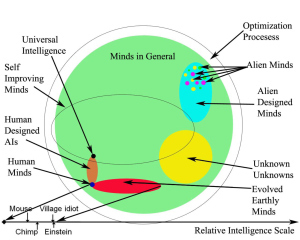 For readers intrigued in what safe variety of AI might be possible, the section of Artificial Superintelligence early in the book will be of great interest. Yampolskiy describes five taxonomies of minds (pp 31-34). Returning to re-read this section after having completed the rest of the book can be quite beneficial, as at this point readers can more fully understand how AI that is Quantum and Flexibly Embodied according to Goetzel taxonomy (p 31) with Ethics Self-Monitoring (p 122) might help ensure development of safe AI. If such AI systems include error-checking, with firmware (unerasable) dedication to preserving others and constantly checking to seek and resonate with highest-order intelligence with quantum levels of sensing through time-reversible logic gates (in accordance with quantum deductive logic), one can begin to breathe a sigh of relief that there might just be a way to ensure safe AI will prevail.
For readers intrigued in what safe variety of AI might be possible, the section of Artificial Superintelligence early in the book will be of great interest. Yampolskiy describes five taxonomies of minds (pp 31-34). Returning to re-read this section after having completed the rest of the book can be quite beneficial, as at this point readers can more fully understand how AI that is Quantum and Flexibly Embodied according to Goetzel taxonomy (p 31) with Ethics Self-Monitoring (p 122) might help ensure development of safe AI. If such AI systems include error-checking, with firmware (unerasable) dedication to preserving others and constantly checking to seek and resonate with highest-order intelligence with quantum levels of sensing through time-reversible logic gates (in accordance with quantum deductive logic), one can begin to breathe a sigh of relief that there might just be a way to ensure safe AI will prevail.
While the deepest pockets of government funding are unlikely to ever make plans to develop such a system that would not be controlled by anything less than the greatest intelligence seekable by AI (such as God), it is conceivable that humanitarian philanthropists will step forward to fund such a project in time that all of us will be eternally grateful that its highest-order-seeking AI will prevail.
___________________________
 Cynthia Sue Larson
is the best-selling author of six books, including Quantum Jumps. Cynthia has a degree in Physics from UC Berkeley, and discusses consciousness and quantum physics on numerous shows including the History Channel, Coast to Coast AM, the BBC and One World with Deepak Chopra. You can subscribe to Cynthia’s free monthly ezine at: http://www.RealityShifters.com
Cynthia Sue Larson
is the best-selling author of six books, including Quantum Jumps. Cynthia has a degree in Physics from UC Berkeley, and discusses consciousness and quantum physics on numerous shows including the History Channel, Coast to Coast AM, the BBC and One World with Deepak Chopra. You can subscribe to Cynthia’s free monthly ezine at: http://www.RealityShifters.comRealityShifters®


August 31, 2015
Berenstain Bears, Mandela Effect, Thanksgiving Thursday
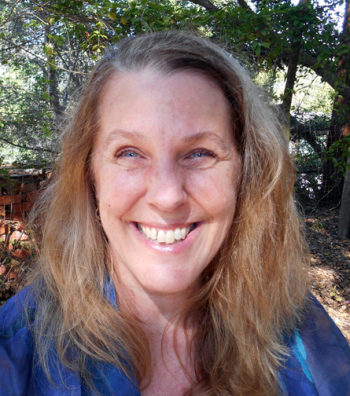 The biggest alternate universes popular meme recently has been the Berenstein Bears / Berenstain Bears
The biggest alternate universes popular meme recently has been the Berenstein Bears / Berenstain Bears
After sixteen years of regularly covering the topic of alternate histories–sometimes rapidly changing alternate histories–I’m delighted to see some specific cases of reality shifts and quantum jumps being so widely reported that some bigger media channels are taking notice recently.
While realityshifters like me are conservatively reporting at least one rather noticeable reality shift or quantum jump every day, many newcomers to this phenomena are viewing this subject with astonishment mixed with understandable incredulity as they discuss the “Mandela effect” or the “Berenstain Bears” controversy. For newcomers to the world of reality shifts, typically only one thing is currently being noticed as having mysteriously changed–so naturally their focus of attention is on the what, when, where, how, and why of that particular shift.
 The Berenstein Berenstain Bears story has this month been covered by MTV, Seventeen magazine, the Globe and Mail, the New Zealand Herald, and the Mandela Effect website, While reporters maintain a cheeky attitude of playful irreverence when covering this topic, such as when New Zealand Herald reporter, Karl Puschmann, asks us to spell the name of the family of bears we came to know and love as children, “Did you spell it Berenstein or Berenstain? The former is right, but wrong. The latter is officially correct but undoubtedly incorrect. Everything we thought we knew is a lie. In case you’re wondering, yes, I am wearing my best tinfoil hat right now but let me assure you, this is only as a safety precaution. I’m not a nutter or anything. Honestly.”
The Berenstein Berenstain Bears story has this month been covered by MTV, Seventeen magazine, the Globe and Mail, the New Zealand Herald, and the Mandela Effect website, While reporters maintain a cheeky attitude of playful irreverence when covering this topic, such as when New Zealand Herald reporter, Karl Puschmann, asks us to spell the name of the family of bears we came to know and love as children, “Did you spell it Berenstein or Berenstain? The former is right, but wrong. The latter is officially correct but undoubtedly incorrect. Everything we thought we knew is a lie. In case you’re wondering, yes, I am wearing my best tinfoil hat right now but let me assure you, this is only as a safety precaution. I’m not a nutter or anything. Honestly.”
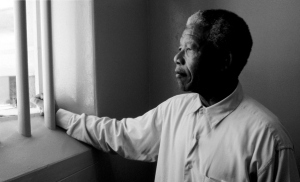 The Mandela Effect has gained similar traction recently, being reported this past month in the Corsicana Daily Sun, CKNW News Talk, and The Globe and Mail. I first wrote about having remembered Nelson Mandela passing away while incarcerated in my blog and the August 2013 issue of RealityShifters. Over the past couple of years, increasing numbers of people have remembered that they, too, have memories of Mandela dying years earlier than his more recent passing. There was so much interest in this so-called “Mandela Effect,” which is part of what RealityShifters has been calling the “Alive Again” phenomenon since May 2004, that Reddit readers talked about it recently, and that Fiona Broome created her Mandela Effect website in 2011.
The Mandela Effect has gained similar traction recently, being reported this past month in the Corsicana Daily Sun, CKNW News Talk, and The Globe and Mail. I first wrote about having remembered Nelson Mandela passing away while incarcerated in my blog and the August 2013 issue of RealityShifters. Over the past couple of years, increasing numbers of people have remembered that they, too, have memories of Mandela dying years earlier than his more recent passing. There was so much interest in this so-called “Mandela Effect,” which is part of what RealityShifters has been calling the “Alive Again” phenomenon since May 2004, that Reddit readers talked about it recently, and that Fiona Broome created her Mandela Effect website in 2011.
While I’ve not yet seen such widespread reports of America’s Thanksgiving Third Thursday switch from the third to the fourth Thursday of November, I’m sure that’s just a matter of time. Over the past two years, I’ve been receiving increasing numbers of reports from people who do remember that American Thanksgiving “always” fell on the third Thursday of November. I published the first such report in the November 2013 RealityShifters, with follow-up confirmation from others with similar memories in the January 2015 RealityShifters, the February 2015 RealityShifters, and the May 2015 RealityShifters. Clearly, there’s some kind of momentum for remembering alternate histories, as increasing numbers of people are agreeing that they, too, remember things differently than supposedly have “always been true.” As one of the many people who remember Thanksgiving being on the third Thursday of each month, I can assure you I never would have scheduled International Aura Awareness Day to fall on Thanksgiving weekend. Which is why I’m quite certain that I’ve experienced a change in the past few years, despite there being no current historical record that such a change has occurred.
Oliver Sacks Dies… Again
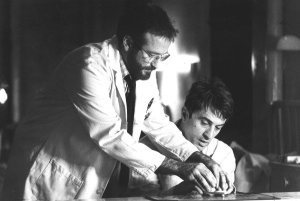 The perspective on such topics as these for realityshifters like me is naturally more accepting and relaxed, due to the steady flow of such “unusual” happenings in our everyday lives. For example, as I sip my morning cup of coffee today, I read today’s New York Times article about Oliver Sacks having passed away, I recognize this “news” story as one I read rather recently, just a week or two ago. In fact, it is so familiar that the photo of Robin Williams with Robert De Niro in Williams’ role playing a character based on Sacks in the movie “Awakenings” is the exact same one I saw very recently. I double-check the date of Oliver Sacks’ death, and see that as of today, he’s supposedly passed away today, Sunday, August 30th. I confirm this date by running a quick search engine check, to make sure it wasn’t really a couple of weeks ago, and all sources agree on today–Sunday, August 30th. Because I’ve already read a nearly identical version of this obituary, I am able to skim it quickly today, which I’m happy to find provides me with a bit more time to work on writing this blog post that I wouldn’t otherwise have.
The perspective on such topics as these for realityshifters like me is naturally more accepting and relaxed, due to the steady flow of such “unusual” happenings in our everyday lives. For example, as I sip my morning cup of coffee today, I read today’s New York Times article about Oliver Sacks having passed away, I recognize this “news” story as one I read rather recently, just a week or two ago. In fact, it is so familiar that the photo of Robin Williams with Robert De Niro in Williams’ role playing a character based on Sacks in the movie “Awakenings” is the exact same one I saw very recently. I double-check the date of Oliver Sacks’ death, and see that as of today, he’s supposedly passed away today, Sunday, August 30th. I confirm this date by running a quick search engine check, to make sure it wasn’t really a couple of weeks ago, and all sources agree on today–Sunday, August 30th. Because I’ve already read a nearly identical version of this obituary, I am able to skim it quickly today, which I’m happy to find provides me with a bit more time to work on writing this blog post that I wouldn’t otherwise have.
As amazing as one might expect it should be to me for me to see an obituary run for a second time in the New York Times as if it’s fresh news all over again, such experiences with repeating events are really nothing new for me. I now realize that seeing New York Times front page obituary news more than once is similar to my having tired of overplayed songs on the radio in the 1970s as a youth, only to hear radio announcers gleefully announce the exciting world debut of those songs as “being played for the first time.” While I dismissed such things as somebody’s confusion in my youth, I’ve now become consciously aware of regularly occurring alternate histories, so surfing through them is a natural part of my life.
Joys of Reality Shifts: Lost Earring Returns
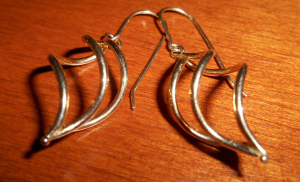 There are times when being a realityshifter is truly a delight. Rather than accepting a given situation as fixed or unchangeable, I am keenly aware of just how flexible reality can be. During a walk one evening with a friend along a city sidewalk, I noticed upon reaching my car that one of my gold earrings was no longer on my ear. These earrings have special sentimental value to me, since I received them as a gift from my parents, and they’re pretty, too. I asked my friend to continue on without me, so I would have time to retrace my steps and see if I could find the earring on the sidewalk or street. I entered a state of relaxed, energized, loving awareness, as I walked back and forth along the several blocks of sidewalk and street. I imagined our recently deceased family dog was walking with me, since he always helped me find things–often by helping me visualize where they were. I’d told my friend and colleague, Dr. Beverly Rubik, about our dog’s death earlier that same day at lunch, and she’d told me how she’d heard bells playing when she buried her beloved pet dog–though strangely, there were no bells nearby. Though I’d not heard bells when burying our family dog, realized I was now hearing the sound of the UC Berkeley Sather Tower campanile bells playing a beautiful tune! I felt tremendous love in my heart for my dog, for the campanile music, and for being alive. I checked my hair and clothes one more time, hoping that perhaps my earring never hit the ground. I sensed a question posed to me, “Where would you like to find it?” My telepathic reply to this silent question was simply “Somewhere safe.” I’d much rather find it in good shape, rather than flattened by a 3,000 pound car driving by. I realized after retracing my steps for a second meticulous time, that as much as I adore my earring, I was willing to accept not being able to find it for the time being. So, for a few hours I ignored my missing earring and went to the Foundations of Mind conference reception party, visited with friends, and finally returned home. And that’s when, to my great surprise and delight, tucked deep down inside my clothes in a place that makes no sense for it to be–and certainly not without my having felt it and been annoyed by its presence–was my missing earring, in perfect condition, completely safe!
There are times when being a realityshifter is truly a delight. Rather than accepting a given situation as fixed or unchangeable, I am keenly aware of just how flexible reality can be. During a walk one evening with a friend along a city sidewalk, I noticed upon reaching my car that one of my gold earrings was no longer on my ear. These earrings have special sentimental value to me, since I received them as a gift from my parents, and they’re pretty, too. I asked my friend to continue on without me, so I would have time to retrace my steps and see if I could find the earring on the sidewalk or street. I entered a state of relaxed, energized, loving awareness, as I walked back and forth along the several blocks of sidewalk and street. I imagined our recently deceased family dog was walking with me, since he always helped me find things–often by helping me visualize where they were. I’d told my friend and colleague, Dr. Beverly Rubik, about our dog’s death earlier that same day at lunch, and she’d told me how she’d heard bells playing when she buried her beloved pet dog–though strangely, there were no bells nearby. Though I’d not heard bells when burying our family dog, realized I was now hearing the sound of the UC Berkeley Sather Tower campanile bells playing a beautiful tune! I felt tremendous love in my heart for my dog, for the campanile music, and for being alive. I checked my hair and clothes one more time, hoping that perhaps my earring never hit the ground. I sensed a question posed to me, “Where would you like to find it?” My telepathic reply to this silent question was simply “Somewhere safe.” I’d much rather find it in good shape, rather than flattened by a 3,000 pound car driving by. I realized after retracing my steps for a second meticulous time, that as much as I adore my earring, I was willing to accept not being able to find it for the time being. So, for a few hours I ignored my missing earring and went to the Foundations of Mind conference reception party, visited with friends, and finally returned home. And that’s when, to my great surprise and delight, tucked deep down inside my clothes in a place that makes no sense for it to be–and certainly not without my having felt it and been annoyed by its presence–was my missing earring, in perfect condition, completely safe!
Primacy of Quantum Logic in the Natural World
So what’s going on? Occam’s Razor invites us to avoid over-complicating explanations of what’s going on. William of Ockham’s words on this matter were, “Pluralitas non est ponenda sine neccesitate,” which translates to “entities should not be multiplied unnecessarily.” Curiously, or perhaps appropriately for our topic, much controversy occurs when scholars attempt to provide proper attribution for this quote, as noted in this article called “The Myth of Ockham’s Razor,” at the Logic Museum. In complete harmony with the fact that it appears there might currently be no physical evidence of any kind to support that William of Ockham is the true origination of the idea behind Occam’s Razor, the arrival of a fresh understanding of Quantum Logic in time to provide a framework for new Quantum Computers provides us valuable insights regarding our mistaken long-standing presumption that Classical, Boolean Logic is all that deductive logic is about. Obviously, this is not the case, as I summarized in my most recent blog post, Different Memories are to be Expected in the Quantum Age.
Reality as found in Nature, like consciousness itself, has a wild, unpredictable, untamed, nonlinear quality to it. The reality I’ve seen and come to know and love has occasionally changing “facts,” such as whether or not American Thanksgiving has always fallen on the fourth Thursday of November, Nelson Mandela died in prison, the Berenstain Bears were once known as Berenstein, or William of Ockham really was the first person to popularize the notion of “Pluralitas non est ponenda sine neccesitate” in the Middle Ages. In Quantum Logic, both the past and the future can change, and often do. It’s up to us to bring conscious attention and awareness to what truly matters most to us. This is the foundation for the paper I presented this month at Foundations of Mind: A Dialogue of World Views, at UC Berkeley. The title of my paper is, “Quantum Logic is Primary in the Natural World.” It will be published along with other papers presented at the conference in the coming year.
You can watch the video edition of this post on YouTube at: http://youtu.be/xvN5s34JfoM
___________________________
 Cynthia Sue Larson
is the best-selling author of six books, including Quantum Jumps. Cynthia has a degree in Physics from UC Berkeley, and discusses consciousness and quantum physics on numerous shows including the History Channel, Coast to Coast AM, the BBC and One World with Deepak Chopra. You can subscribe to Cynthia’s free monthly ezine at: http://www.RealityShifters.com
Cynthia Sue Larson
is the best-selling author of six books, including Quantum Jumps. Cynthia has a degree in Physics from UC Berkeley, and discusses consciousness and quantum physics on numerous shows including the History Channel, Coast to Coast AM, the BBC and One World with Deepak Chopra. You can subscribe to Cynthia’s free monthly ezine at: http://www.RealityShifters.comRealityShifters®


August 30, 2015
Reparsing Nature at Foundations of Mind II
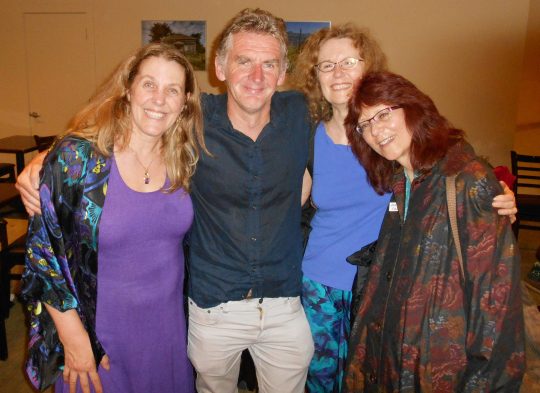
Cynthia Sue Larson, Seán Ó Nualláin, Beverly Rubik, and Maria Syldona at the Foundations of Mind reception
The Foundations of Mind II conference may be over, but the conversation is heating up.
The Foundations of Mind II conference took place at UC Berkeley this month, featuring presentations by Fritjof Capra, Stuart Kauffman, Henry Stapp, Bob Doyle, Howard Pattee, Jacob Needleman, Walter Freeman, Stuart Hameroff, Jonathan Schooler, Glenn Aparicio Parry, Beverly Rubik, Acacio de Barros, Carlos Montemayor, Len Talmy, Bob Petr, Judy Gardiner, Julia Bystrova, Maria Syldona, Leanne Whitney, Tania Re, Wolfgang Baer, Markate Daly, Justin Riddle, Seán Ó Nualláin, and many more. With three information-rich days of conference proceedings, and ongoing conversations that ran long into most nights, this year’s conference was a veritable feast of interdisciplinary ideas, wisdom and information from around the world.
Videos from the conference presentations will be available through the Foundations of Mind website, and papers will be published in the future, too. People registered through Foundations of Mind are joining in several threads of on-going conversations begun at the conference, and moving forward to explore topics of the quantum paradigm, consciousness, biosemiotics, and higher education.
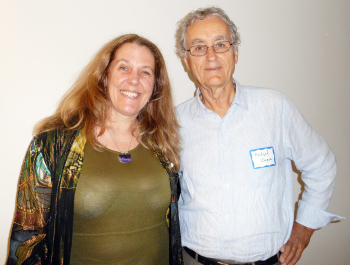
Cynthia Sue Larson and Fritjof Capra
A Systems View of Life
Fritjof Capra talked about moving from a mechanistic to a systemic network view of life, in which there is a more unified view of mind, matter, and life. “Evolution is no longer seen as a competitive struggle, but a cooperative dance.” Capra described the theory of autopoiesis, which defines biological life as a pattern of self organization within a boundary of its own making. With this definition, Capra pointed out, “plants have consciousness, too!” The Santiago Theory of cognition is a non-representational (non-symbolic) theory that identifies cognition–the process of knowing–with the process of life. Life and cognition are inseparably connected, and perception and behavior do not require a brain or nervous system. The Santiago Theory overcomes the Cartesian division of mind and matter, so that mind is not a ‘thing,’ but instead represents the self-organizing process aspect of life, and matter represents the complementary aspect of structure.
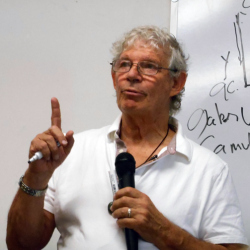
Stuart Kauffman
Biology and Evolution
Stuart Kauffman pointed out that there is no propositional system to determine the number of uses for a screwdriver. The number is necessarily infinite, since new functions can exist that could not be determined in advance. Functions are important to us, so we have hearts that pump blood, yet biological systems cannot be reduced to physics. Kauffman stated, “What’s propagating is not DNA or genes–it’s functional sufficiencies.” The key point is that new actuals constantly arise that enable–rather than cause–new possibilities. Once a swim bladder develops in a given animal, for example, a new function–buoyancy–begins to exist. And once that swim bladder exists, it’s possible for bacteria to live in that swim bladder. Here we see that reductionism must fail, since biological evolution creates new actuals that nobody can foresee, which were all enabled by what came before.
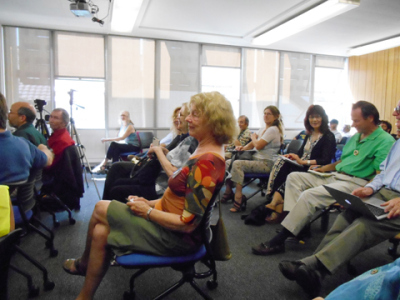
Gurdjieff View of Consciousness
Jacob Needleman described how George Ivanovich Gurdjieff spoke of consciousness as being pure presence, with many levels. Only when all three minds (mental, feelings, and instinctive)–all three centers of perception–work together can real consciousness begin. Gurdjieff describes the “many I’s” present in each of us, but for most people experiencing this, it comes as a tremendous shock to the ego. Needleman pointed out that, “Man is here for some reason, and everything serves a purpose. What does mankind serve on Earth?” Gurdjieff explained that a transmitting station operates through man’s consciousness, which Earth needs: “Awakened man can change the world.”
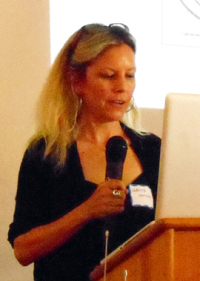
Leanne Whitney
Living the Quantum Paradigm
Sky Nelson and Jim Johnston kicked off the conference with dialogue about how it feels to experience synchronicity, love, and connectedness while living in keeping with the quantum paradigm–as physicists themselves. Judy Gardiner talked about dreams and dream symbols, Shiva Meucci summarized key points of focus in consciousness and physics, Cynthia Sue Larson presented the paper, “Quantum Logic is Primary in the Natural World,” Leanne Whitney delved into Patanjali’s concepts of the purusa ontic reality, Jim Johnston talked about quantum dynamic variables, Maria Syldona provided an experience of consciousness from Kashmir Shaivism, and Julia Bystrova presented a poetic transdisciplinary perspective.
A Veritable Smorgasbord of World Views
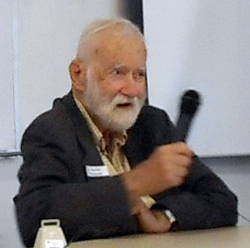
Walter Freeman
Leonard Talmy provided insights into how language structures concepts; Seán Ó Nualláin talked about education, mindfulness and high performance; Justin Riddle led an exploration into the fractal cognitive triad; Jonathan Schooler invited us to ponder how an additional subjective dimension of time might provide a meta-perspective bridging science and experience; and J. Acacio de Barros investigated quantum mechanics by encouraging us to more thoroughly contemplate who has a mind.
Henry Stapp discussed the quantum zeno effect, and the intriguing way that if you keep asking the same question repeatedly and rapidly enough, it stays in the “yes” answer mode. Walter Freeman discussed four steps by which animals create knowledge and meaning from microscopic sensory information. Beverly Rubik described the importance of the biofield hypothesis for appreciating how consciousness is the conductor for the energetic ‘symphony.’ Howard Pattee pointed out that we can’t have just one model that handles everything–we need complementary models. Bob Doyle described the temporal sequence to free will, starting first with “free,” followed by “will.”
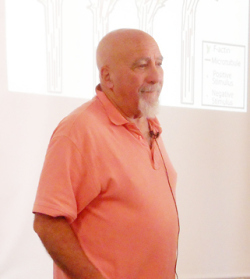
Stuart Hameroff
Sebastian Benthall talked with Seán Ó Nualláin about ideas for improving higher education, and the notion of one magisterium. Glenn Aparicio Parry discussed the value of considering original thinking–that which was there first–from an indigenous perspective, in terms of accessing the full continuum of consciousness. Markate Daly described how three moral qualities of trust, reciprocity and care contribute to provide social order. Petr Bob asked whether the non-classical mind exists, pointing out that the binding problem anticipated by Descartes still exists. Wolfgang Baer reviewed the compatibility of physical assumptions with the foundations of mind. Frank Heile presented a three agent theory to explain religion, spirituality, and enlightenment. Jeffery Martin talked about the wonders of transformative technology. Karla Galdamez described experimental apparatus for measuring wave function collapse.
Stuart Hameroff discussed the “quantum pleasure principle,” in which consciousness creates a flow of time. Juan Acosta-Urquidi discussed positive neurophenomenology affects from medicinal qualities of plants. Tania Re described a bridge between anthropology, medicine and physics in the way cultures access different state of consciousness for healing. Yoshio Nakamura shared research findings about mindfulness meditation and nondual awareness. Jerry Gin presented biogeometry tools, materials and ideas. Sperry Andrews discussed humanity’s capacity to share a common sense. Rodney Albert Ferguson brought joyful levity to a spirited discussion about how alive, conscious, and free we truly are.
___________________________
 Cynthia Sue Larson
is the best-selling author of six books, including Quantum Jumps. Cynthia has a degree in Physics from UC Berkeley, and discusses consciousness and quantum physics on numerous shows including the History Channel, Coast to Coast AM, the BBC and One World with Deepak Chopra. You can subscribe to Cynthia’s free monthly ezine at: http://www.RealityShifters.com
Cynthia Sue Larson
is the best-selling author of six books, including Quantum Jumps. Cynthia has a degree in Physics from UC Berkeley, and discusses consciousness and quantum physics on numerous shows including the History Channel, Coast to Coast AM, the BBC and One World with Deepak Chopra. You can subscribe to Cynthia’s free monthly ezine at: http://www.RealityShifters.comRealityShifters®


August 4, 2015
Different Memories are to be Expected in the Quantum Age
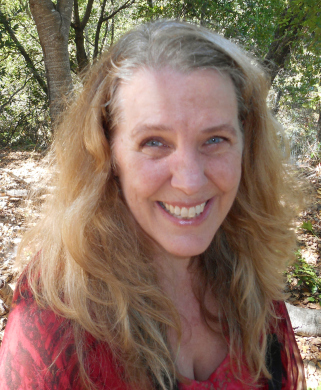 Have you noticed how things often aren’t the way you remember them? Or that your memories are sometimes quite different from your family and friends?
Have you noticed how things often aren’t the way you remember them? Or that your memories are sometimes quite different from your family and friends?
Different memories are to be expected in the Quantum Age. Facts do not always stay fixed, and we will increasingly recognize changes in the way we remember the past that differ from previous memories. Noticing differences in the way we remember previous events is an intrinsic part of the true nature of reality. I write about the way our memories can be observed to change in our own lives, and in relationship to friends and family in my book, “Quantum Jumps,” where I write about “flashbulb” memories, and the way we can observe shifts in reality in which people don’t agree on what happened, since they recall different pasts.
We’re living in an extraordinary time, as quantum technology brings humanity to the brink of entering the Quantum Age. At this juncture, some surprises are in store for everyone, as we finally begin to acknowledge that Boolean logic is seen to be a subset and special case of quantum logic.
What we think of as analytical logic is thus partially complete, partially true. Quantum logic includes a much broader awareness of four-fold logic, similar to logic as long understood in Asia, in which we do have binary categories of “True” and “False,” but we appreciate there are even larger categories of “True-and-False” and “Not-True-Not-False.”
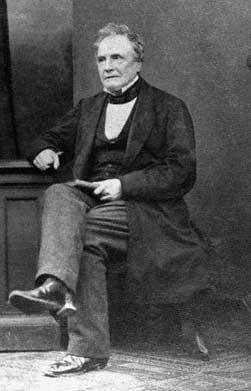
Charles Babbage
Quantum logic is necessary in order that quantum computers can be programmed, just as Boolean logic sprang into being in 1847 in conjunction with Charles Babbage developing the first programmable device with his Babbage computer–which was the forerunner of all of today’s classical computers. George Boole’s Boolean logic had not really been necessary prior to the advent of classical computers, but in the 1800s we suddenly did have a need for a kind of logic that could be relied upon to get consistent answers to problems. We take for granted that rational thinking is equivalent with Boolean logic, yet Boolean logic is certainly not the only kind of logic that exists. It is a relatively straightforward logic in which decision trees can be easily understood in terms of Boolean logic gates, making it perfect to be at the heart of the classical digital revolution in the Information Age.
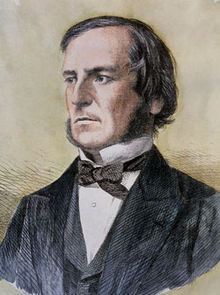
George Boole
Quantum logic is required in order for computer programmers and developers to get their minds around quantum logic gates as the rush is on to develop the first true quantum computers. Quantum logic is generally recognized as being a more encompassing type of logic than Boolean logic, which is widely viewed as being a special case of quantum logic. What this means for our conceptualization of what is “logical” and “rational” is that a whole new kind of worldview is about to come into global prominence. Many assumptions that seem logical and rational according to Boolean logic are far too limited for quantum logic–and that includes assumptions that we only need pay attention to material things, that nonlocal effects can be ignored, that there is such a thing as an objective and uninvolved observer, and that we can have precise answers to problems. Quantum logic overturns all these assumptions completely–and also adds the exciting development of two-way logic gates through time. What we end up with is a completely new kind of logic that is far from what Spock often referred to on Star Trek!
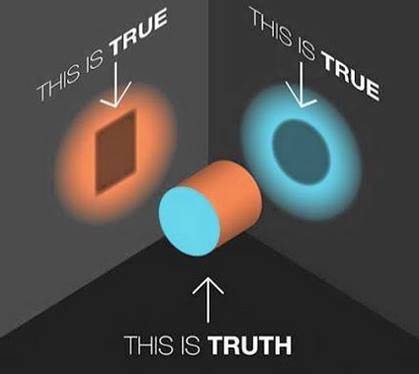 In fact, quantum logic has a lot more to do with synchronicity, a term psychologist Carl Jung coined to signify “the simultaneous occurrence of two meaningful but not causally connected events,” or as “a coincidence in time of two or more casually unrelated events which have the same or similar meaning… equal in rank to a causality as a principle of explanation.” While Spock would most likely have called synchronicity “illogical,” it may turn out to be totally logical when viewed from a perspective of quantum logic. Synchronicity is the occurrence of a physical event in the world near the same time it is being discussed or thought about, and the essence of synchronicity is felt, as there is often significance and meaning associated with it. Quantum logic will most likely begin to show us how this kind of interplay between levels of consciousness can be revealed through coincidences in “internal” thought and “external” action as we play with our sense of identity based on who “we” think we really are.
In fact, quantum logic has a lot more to do with synchronicity, a term psychologist Carl Jung coined to signify “the simultaneous occurrence of two meaningful but not causally connected events,” or as “a coincidence in time of two or more casually unrelated events which have the same or similar meaning… equal in rank to a causality as a principle of explanation.” While Spock would most likely have called synchronicity “illogical,” it may turn out to be totally logical when viewed from a perspective of quantum logic. Synchronicity is the occurrence of a physical event in the world near the same time it is being discussed or thought about, and the essence of synchronicity is felt, as there is often significance and meaning associated with it. Quantum logic will most likely begin to show us how this kind of interplay between levels of consciousness can be revealed through coincidences in “internal” thought and “external” action as we play with our sense of identity based on who “we” think we really are.
Another one of the more surprising aspects of quantum logic is that it shows us that we cannot ever fully know all “facts,” since some necessarily remain in a kind of blurry possibility field. When we combine that uncertainty with the way that quantum logic gates are two-ways through time, we start to see a quantum “mechanism” by which the future can and does influence the past. “Facts” are therefore not entirely fixed, and only awareness–consciousness–remains eternal.
You can watch the video edition of this post on YouTube at: http://youtu.be/xvN5s34JfoM
___________________________
 Cynthia Sue Larson
is the best-selling author of six books, including Quantum Jumps. Cynthia has a degree in Physics from UC Berkeley, and discusses consciousness and quantum physics on numerous shows including the History Channel, Coast to Coast AM, the BBC and One World with Deepak Chopra. You can subscribe to Cynthia’s free monthly ezine at: http://www.RealityShifters.com
Cynthia Sue Larson
is the best-selling author of six books, including Quantum Jumps. Cynthia has a degree in Physics from UC Berkeley, and discusses consciousness and quantum physics on numerous shows including the History Channel, Coast to Coast AM, the BBC and One World with Deepak Chopra. You can subscribe to Cynthia’s free monthly ezine at: http://www.RealityShifters.comRealityShifters®



